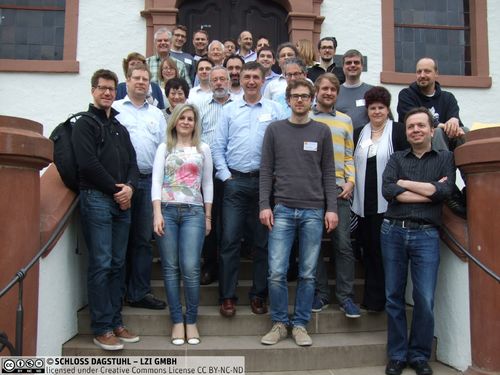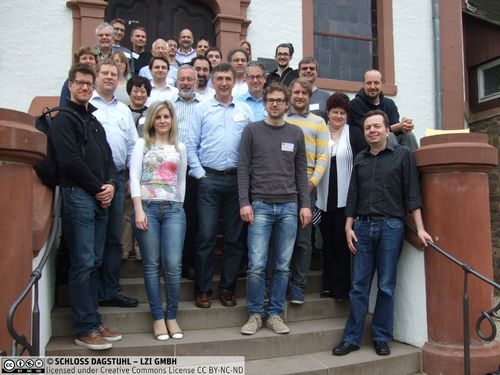Dagstuhl Seminar 14181
Multi-agent systems and their role in future energy grids
( Apr 27 – May 02, 2014 )
Permalink
Organizers
- Michael N. Huhns (University of South Carolina - Columbia, US)
- Wolfgang Ketter (Erasmus University - Rotterdam, NL)
- Ryszard Kowalczyk (Swinburne University of Technology - Melbourne, AU)
- Fabrice Saffre (BT Research - Ipswich, GB)
Coordinator
- Rainer Unland (Universität Duisburg-Essen, DE)
Contact
- Andreas Dolzmann (for scientific matters)
- Christina Schwarz (for administrative matters)
A number of recent events (e.g. Fukushima, Japan, and the largest blackout in history, India) have once again increased global attention for climate change and resource depletion. The re-evaluation of the feasibility of current approaches for future energy generation, distribution, transportation, and consumption has become an exercise for most countries. There is a general consensus on the need for a fundamental transformation of future energy grids (FEG).
The main differences between the current and the envisioned future grid are the production ecosystem on one hand and the information exchange on the other. Current grids traditionally rely on a comparatively stable number of large power plants that produce a constant and predictable amount of power, as well as on smaller power plants that can be activated quickly if demand requires it. Power and information flow from the supply side to the demand side. This is reflected in the underlying business models, which are mainly dictated by the prices the few big producers can achieve on the global market and by the costs for transmitting the power through a distribution system usually owned by private companies. This will change as more and more renewable and distributed generation technologies spread to a household level. The distinction between producer and consumer will become increasingly blurred as the flow of power as well as information among the resultant prosumers becomes bi-directional. The current grid operates at a high-voltage level suited for long distance delivery, while a prosumer-based network will be a more localized and low-voltage grid. Further, the increasing use of renewable sources will result in a less predictable generation pattern, a matter which in itself is raising a number of interesting challenges. In short, the new power grids will differ in magnitude and direction as well as in generation consistency, which will require a complete revision of the underlying business model as the currently predominant global (or, at least, national) market will be replaced by a number of local markets that will have to maintain the balance between supply and (individually generated) demand, i.e., market places for power generation as well as power consumption.
The development of an information and communication technology (ICT) support infrastructure will be the key challenge in the design of an end-to-end smart grid framework. This will require the capability to balance supply and demand and to handle complex operations. The efficient, real-time exchange of information and the coordinated decisions among many stake holders (consumers, distributors, transporters, and generators) have to be supported. This is not possible within the structure and practice of the current grid. Different levels of the grid (layout, control, ICT infrastructure, maintenance, failure handling, and business models), as well as the communication and cooperation among these levels, needs to be fully coordinated with all the other levels. To predict the emergent properties of the system under a range of different conditions and worst-case scenarios, extensive and effective simulation tools will be required.
A solution to this large and very complex problem requires intelligent decisions to be made at each node in the electric power distribution network (grid), especially at the edges. To be manageable, the decisions must take advantage of locality constraints and end-user preferences. A multi-agent system, with agents located at the edges and nodes of the grid and representing the interests of end-users, distributors, and providers, satisfies these requirements. It is thus the default system solution that will be considered first at the Dagstuhl Seminar.
The intent of the proposed discussions among experts from all relevant disciplines is to develop the foundation for the necessary interdisciplinary solution from engineering, computer science, and business management. The result will be understanding and identification of the requirements on the information systems for future smart grids.
Due to the depletion of scarce resources for energy production and the problems associated with climate change, there is widespread interest in new approaches for managing energy generation, distribution, transportation, and consumption. Overall we must find a way to combine the economics, physics, physical components, and governmental policies and regulations of energy systems, while satisfying the personal preferences of consumers. The goal is to create a global Smart Grid.
The main differences between the current and the envisioned future grid are the production ecosystem on one hand and the information exchange on the other. Current grids traditionally rely on a comparatively stable number of large power plants that produce a constant and predictable amount of power, as well as on smaller power plants that can be activated quickly if demand requires it. Power and information flow from the supply side to the demand side. This is reflected in the underlying business models, which are mainly dictated by the prices the few big producers can achieve on the global market and by the costs for transmitting the power through a distribution system usually owned by private companies. This will change as more and more renewable and distributed generation technologies spread to a household level.
The distinction between producer and consumer will become increasingly blurred as the flow of power as well as information among the resultant prosumers becomes bi-directional. The current grid operates at a high-voltage level suited for long distance delivery, while a prosumer-based network will be a more localized and low-voltage grid. Further, the increasing use of renewable sources will result in a less predictable generation pattern, a matter which in itself is raising a number of interesting challenges. In short, the new power grids will differ in magnitude and direction as well as in generation consistency, which will require a complete revision of the underlying business model as the currently predominant global (or, at least, national) market will be replaced by a number of local markets that will have to maintain the balance between supply and (individually generated) demand, i.e., market places for power generation as well as power consumption.
The development of an information and communication technology (ICT) support infrastructure will be the key challenge in the design of an end-to-end smart grid framework. This will require the capability to balance supply and demand and to handle complex operations. The efficient, real-time exchange of information and the coordinated decisions among many stake holders (consumers, distributors, transporters, and generators) have to be supported. This is not possible within the structure and practice of the current grid. Different levels of the grid (layout, control, ICT infrastructure, maintenance, failure handling, and business models), as well as the communication and cooperation among these levels, needs to be fully coordinated with all the other levels. To predict the emergent properties of the system under a range of different conditions and worst-case scenarios, extensive and effective simulation tools will be required. A solution to this large and very complex problem requires intelligent decisions to be made at each node in the electric power distribution network (grid), especially at the edges. To be manageable, the decisions must take advantage of locality constraints and end-user preferences. A multiagent system, with agents located at the edges and nodes of the grid and representing the interests of end-users, distributors, and providers, satisfies these requirements. It is thus the default system solution that was considered first and adopted at the Dagstuhl.
 Michael N. Huhns and Wolfgang Ketter and Ryszard Kowalczyk and Fabrice Saffre und Rainer Unland
Michael N. Huhns and Wolfgang Ketter and Ryszard Kowalczyk and Fabrice Saffre und Rainer Unland
- Marco Aiello (University of Groningen, NL) [dblp]
- Costin Badica (University of Craiova, RO) [dblp]
- Tina Balke-Visser (University of Surrey - Guildford, GB) [dblp]
- Matthias Bürger (Universität Stuttgart, DE)
- Liana Cipcigan (Cardiff University, GB) [dblp]
- Hermann de Meer (Universität Passau, DE) [dblp]
- Christian Derksen (Universität Duisburg-Essen, DE) [dblp]
- Gilbert Fridgen (Universität Bayreuth, DE) [dblp]
- Hanno Hildmann (NEC Laboratories Europe - Heidelberg, DE) [dblp]
- Michael N. Huhns (University of South Carolina - Columbia, US) [dblp]
- Micha Kahlen (Erasmus University - Rotterdam, NL) [dblp]
- Michael Kaisers (CWI - Amsterdam, NL) [dblp]
- Stamatis Karnouskos (SAP SE - Karlsruhe, DE) [dblp]
- Wolfgang Ketter (Erasmus University - Rotterdam, NL) [dblp]
- Sonja Klingert (Universität Mannheim, DE) [dblp]
- Matthias Klusch (DFKI - Saarbrücken, DE) [dblp]
- Ryszard Kowalczyk (Swinburne University of Technology - Melbourne, AU) [dblp]
- Winfried Lamersdorf (Universität Hamburg, DE) [dblp]
- Sebastian Lehnhoff (OFFIS - Oldenburg, DE) [dblp]
- Tobias Linnenberg (Universität der Bundeswehr - Hamburg, DE) [dblp]
- Christoph Mayer (OFFIS - Oldenburg, DE) [dblp]
- Lars Mönch (FernUniversität in Hagen, DE) [dblp]
- Sascha Ossowski (University Rey Juan Carlos, ES) [dblp]
- Peter Palensky (AIT Austrian Institute of Technology - Wien, AT) [dblp]
- Wolfgang Renz (HAW - Hamburg, DE) [dblp]
- Fabrice Saffre (BT Research - Ipswich, GB) [dblp]
- Rainer Unland (Universität Duisburg-Essen, DE) [dblp]
- Konstantina Valogianni (Erasmus University - Rotterdam, NL) [dblp]
- Marjan van den Akker (Utrecht University, NL) [dblp]
- Eric van Heck (Erasmus University - Rotterdam, NL) [dblp]
- Minjie Zhang (University of Wollongong, AU) [dblp]
Classification
- artificial intelligence / robotics
- modelling / simulation
Keywords
- distributed artificial intelligence
- smart grids
- future energy networks
- multi-agent systems
- multi-agent based simulations



 Creative Commons BY 3.0 Unported license
Creative Commons BY 3.0 Unported license
